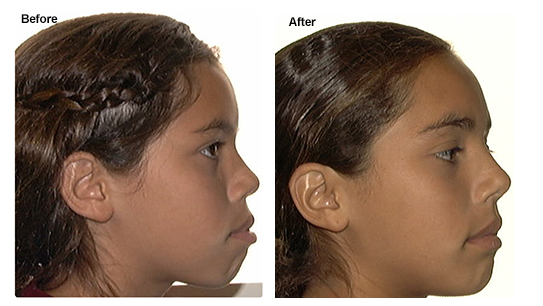November 30th, 2018

POUTING, OR “thrusting out the lip, as in sadness” appears as an expression of displeasure. The lower lip sticks out farther than the upper lip. The chin often has a “golf ball” appearance and the lips strain to close over the teeth.

Jaw And Tooth Structure May Be Causing A Pouting Appearance
Bimaxillary dentoalveolar protrusion produces the appearance of pouting. The jaws and teeth cause the lips to be more prominent than ideal. The lips may be separated at rest, producing a lip opening. In some cases, the appearance of the teeth may not be a problem, but moving the teeth back has a dramatic and desirable effect on the facial profile.

Our Lineage Affects Our Appearance
Lips are influenced by ethnic norms. Northern Europeans have thin lips. Asians and Africans have thicker lips and more tooth prominence. The patient’s desires, nose and chin size, and culture will all influence the orthodontic decision to move teeth back to improved facial appearance.

Have Questions? We Have Answers!
If you have questions about your facial profile, call us at Gorczyca Orthodontics in Antioch, California (925) 757-9000. Find us at www.clubbraces.com. To find an orthodontist near you, visit www.mylifemysmile.org.
If you pout, it may be an indication that your teeth stick out too far. An orthodontist can fix this. So, there’s no need to pout. You’re better off not to pout at any time of the year, and especially when Santa Claus is coming to town.
Tags: Antioch, orthodontist, orthodontics, braces, Gorczyca Orthodontics, tooth extraction, teeth, lips, profile, facial profile, pout, bimaxillary dentoalveo protrusion, bimaxillary protrusion, retraction, tooth retraction, chin, lip competence, lip opening, lip posture, lip, teeth extraction
Posted in Blog | No Comments
October 31st, 2016

WE DON’T think much in our daily lives about being a walking, talking human skeleton. When our orthodontist shows us our lateral cephalogram radiograph for the very first time, it can be quite surprising to see our actual skull and skeleton.

The lateral cephalogram is analyzed by orthodontists for the diagnosis of facial soft tissues influenced by the underlying jaw bone and teeth. Using this analysis, orthodontists produce the beautiful profiles and deliver desires facial esthetics.
Lateral Cephalograms Help Find Certain Bite Issues
When there is a big overjet, overbite, or underbite of the teeth, the lateral cephalometric analysis helps the orthodontist determine which jaw or teeth are responsible for the situation. The analysis of this X-ray can help determine what type of treatment is necessary and whether or not jaw surgery or extractions are needed.

The lateral cephalogram allows the orthodontist to evaluate front tooth position in bone. This helps decide final tooth position for the most stable, beautiful, and functional result. In addition, this analysis indicates whether or not teeth need to be extracted for ideal periodontal health.

The lateral cephalometric analysis gives the orthodontist information about vertical face height and lower jaw angle. This helps decide what treatment mechanics to use to keep the bite functional, beautiful, and closed.

The Lateral Cephalogram Is Critical For Ortho Evaluation
The lateral cephalogram and it's analysis is critical for a thorough orthodontic evaluation. Ask your orthodontist to see your lateral cephalogram radiograph and explain your analysis. Your life may never be the same after the day you realize you are a walking, talking skeleton.
This blog was written by Dr. Ann Marie Gorczyca, Gorczyca Orthodontics, Antioch, California www.clubbraces.com (925) 757-9000. To find an orthodontist near you, visit the American Association of Orthodontists at www.mylifemysmile.org.
Tags: orthodontist, orthodontics, braces, openbite, overbite, overjet, Underbite, facial esthetics, skeleton, Lateral cephalogram, lateral ceph, cephalometrics, dental radiology, imaging, tooth position, jaw position, cephalometric analysis, orthodontic analysis, soft tissue analysis, soft tissue, soft tissue profile, beauty esthetics, beauty, esthetics, facial profile
Posted in Blog | No Comments
















